Thien Mu Pagoda in Hue is a famous tourist destination that you definitely need to visit at least once. At the request of many people, Danang Private Car will write a detailed review about this ancient temple. Do not miss!
About Thien Mu Pagoda in Hue
Thien Mu Pagoda has appeared a lot in Vietnamese folk songs and proverbs and is also the inspiration for many poetic and painting works.
Hue Thien Mu Pagoda, also known as Linh Mu Pagoda, is an ancient “famous” temple about 5 km west of Hue city center. Thien Mu Pagoda was officially established in the year of Tan Suu, during the reign of Lord Tien Nguyen Hoang – the first Nguyen lord in Dang Trong.
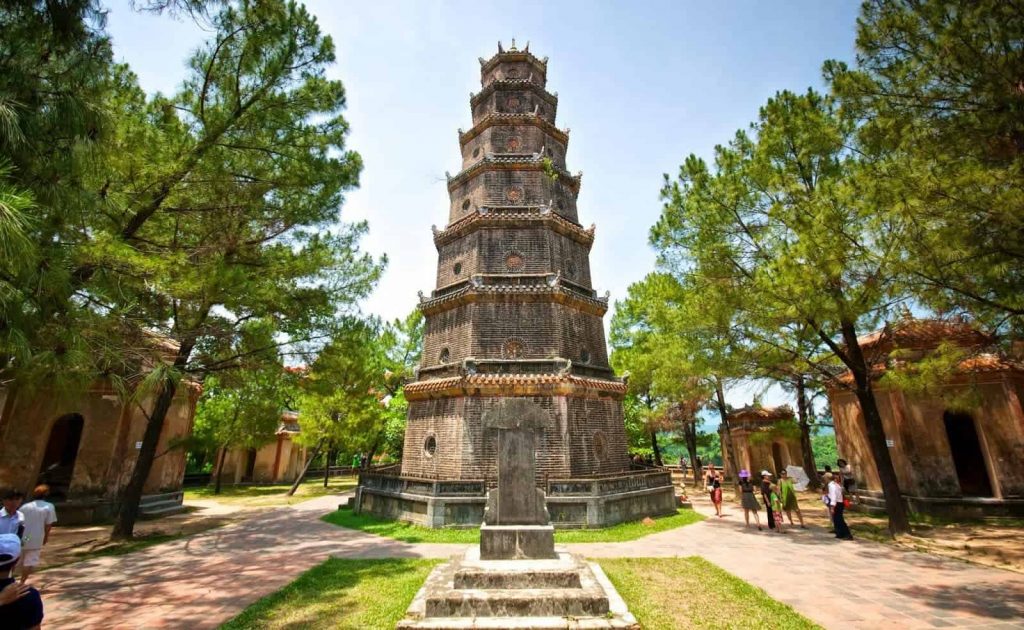
Thien Mu Pagoda in Hue is a symbol associated with the ancient capital for generations, and is also one of the most mentioned landmarks in the journey to discover this city.
Going to Thien Mu Pagoda, you will admire the ancient and profound beauty, the peace of the poetic Perfume River and understand more about the mysterious story behind it.
Where is Thien Mu Pagoda?
Where is Hue ancient capital? Where is Thien Mu Pagoda? Thien Mu Pagoda in Hue is considered a religious and spiritual symbol and possesses a poetic and lyrical scene, so this is considered the most beautiful temple in the inner region. The pagoda is located right on Ha Khe hill, Nguyen Phuc Nguyen street, in Kim Long ward, Hue city.
Thien Mu Pagoda (also known as Linh Mu Pagoda) is located on Ha Khe hill, on the left bank of the Perfume River. About 5km from the center of Hue city to the west in the territory of Huong Tra district.
The Legend of Thien Mu Pagoda Thien Mu Pagoda
officially established in the year of Tan Ox (1601) of the reign of Lord Nguyen Hoang – the first Nguyen lord in Dang Trong. Thien Mu is the oldest ancient pagoda in Hue with a lifespan of more than 400 years. Built in 1601 during the reign of King Nguyen Hoang. According to many recorded documents, in one visit to consider the terrain to build a map. King Nguyen Hoang met a hill named Ha Khe with the image of a dragon turning its head. Later, the king built a temple on this hill, named Thien Mu pagoda.
Architecture of Thien Mu Pagoda Thien Mu Pagoda
Hue has undergone many renovations and expansions, becoming a temple with a strong architectural impression. Thien Mu Pagoda is a complex of many superficial and beautiful architectural works, bearing the unique architecture of Hue ancient capital. Typical architectural works must be mentioned such as: Dai Hung Palace, Phuoc Duyen Tower, Quan Am Palace, …
All create an ancient and sacred beauty for the temple. This is also a place to store many valuable antiques such as horizontal paintings, ancient couplets, ancient statues, steles and bronze bells, which not only have historical significance but also have great artistic value.
Thien Mu pagoda bell
The steady and slow ringing of the bells of Thien Mu Pagoda is an “indescribable” beauty that flutters people’s hearts. And a special feature is that these bronze bells have a unique moon and moon shape.
How to get to Thien Mu Pagoda?
Because Thien Mu Pagoda is only 5km away from the city center, getting there is very simple. You can choose to travel by motorbike, car, taxi, or join a guided tour. Additionally, you can opt for a boat ride on the Perfume River to enjoy the scenic view of the river and fully appreciate the beauty of Thien Mu Pagoda from a distance.
In terms of directions, based on the experience of visiting Thien Mu Pagoda, travelers should take Dang Thai Than Street and then turn left onto Yet Kieu Street. From there, continue straight and turn left onto Le Duan Street. When you reach a roundabout, take a right onto Kim Long Street, and after 2km, you will arrive at the pagoda.
Furthermore, if you wish to explore various attractions in Hue such as the Imperial City and the royal tombs, you can easily book private tour services with professional drivers in Hue from DanangPrivateCar.com. They provide convenient door-to-door transportation, making it effortless for you to explore the famous tourist spots in Hue.
If you are in Da Nang or Hoi An, the easiest way to reach Thien Mu Pagoda is to book a day trip from Danang to Hue. Besides Thiên Mụ Pagoda, you can also visit Hai Van Pass, Lang Co Beach, Lap An Lagoon, the Imperial City, and many other attractions.
The Best Time to Visit Thien Mu Pagoda
You can visit Thien Mu Pagoda at any time of the year; however, if you want to choose the best time, it is probably during the early months of the year, from January to March. This is when the weather is pleasantly cool, the atmosphere is comfortable, making it very suitable for enjoying the scenic beauty of the pagoda.
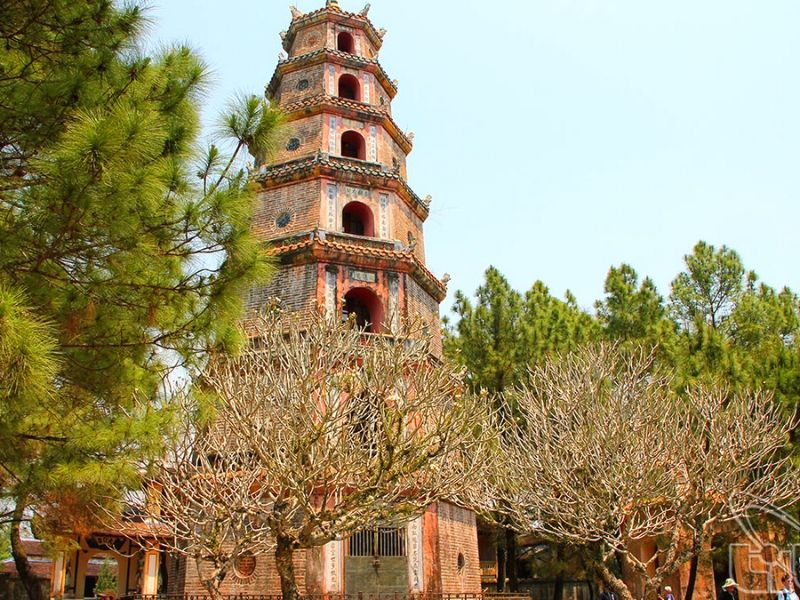
Ticket price to visit Thien Mu Pagoda in Hue
If you are wondering how much tickets to visit Thien Mu Pagoda cost, don’t worry! Thien Mu Pagoda is open to visitors and Buddhists everywhere to visit and worship the temple.
Places to visit in Thien Mu Pagoda
If you are looking for places to visit in the beautiful and attractive Thien Mu Pagoda. The locations below will not disappoint you.
Dai Hung Palace Thien Mu Pagoda
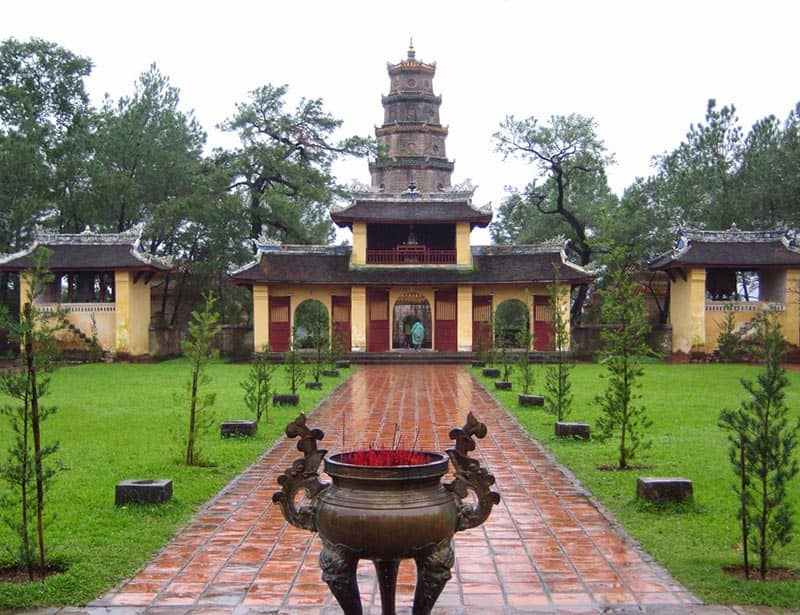
As the main hall of the temple, the place of worshiping Maitreya Buddha has huge ears as if to listen to the suffering of sentient beings and has a big belly that is tolerant of people’s mistakes. The palace has the architecture of Trung Thien Phap snail which was restored in 1959, the columns and trusses are poured with concrete, the outside is covered with a layer of imitation wood paint.
Phuoc Duyen Tower – The Symbol of Thien Mu Pagoda
Phuoc Duyen Tower is a must-visit landmark when traveling to Thien Mu Pagoda in Hue. This structure is located right after the entrance gate. Despite being in the front, Phuoc Duyen Tower is considered the “soul” of the pagoda. Its architecture, along with other structures, forms a cohesive ensemble, showcasing a unique and distinctive yet distinctly Huean charm.
Phuoc Duyen Tower was constructed in 1844 by King Thieu Tri. Initially named Tu Nhan Tower, it was later changed to its current name. At that time, to complete the tower, materials such as clay, blue stone, and Bat Trang pottery had to be transported from outside.
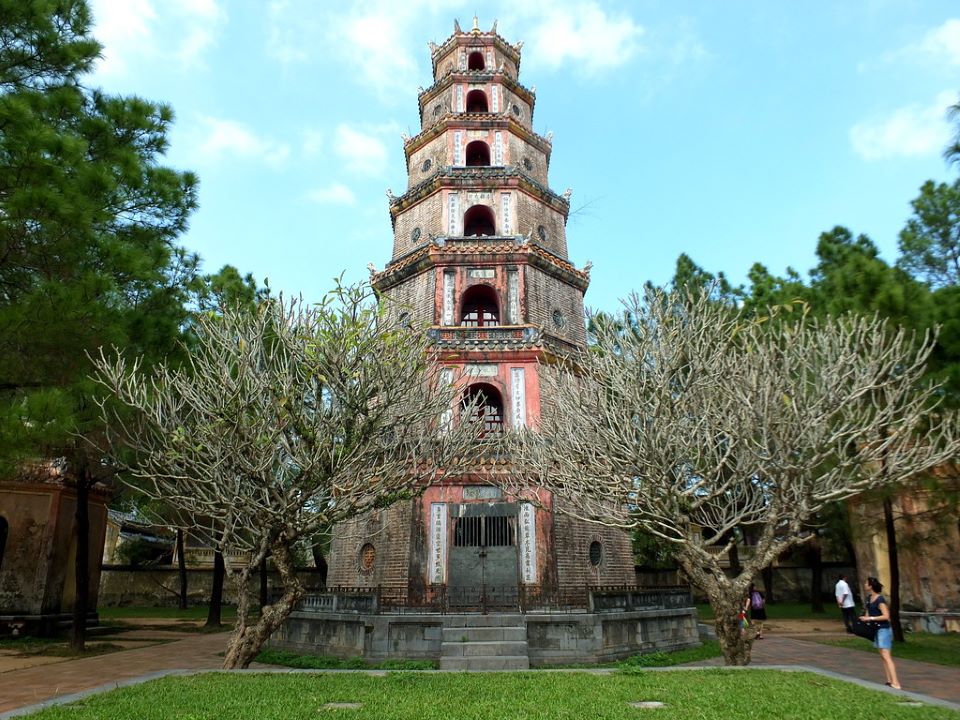
The tower’s body is made of wooden bricks, and the decorative ledges are built from blue stone. All these elements come together to form an octagonal-shaped tower, tapering as it rises, with a total of 7 levels, each measuring 2 meters. Overall, the design of each level is identical and painted in pink. Over the years, it has acquired the marks of time, enriching the distinctive value of the Ancient Capital’s architecture.
The tomb of the late monk Thich Don Hau
At the end of the temple grounds is the tomb of the late monk Thich Don Hau. This place was built to worship the famous master of Thien Mu pagoda – monk Thich Don Hau.

He spent his whole life devoted to charitable activities to help the world. The tomb area also has a 7-storey tower, but the scale is smaller than Phuoc Duyen tower.
Dia Tang Temple
Dia Tang Temple is located behind the Dai Hung Palace. The scenery here is incredibly tranquil and peaceful, with lush greenery and calm water. It is a perfect place for people to relax their minds and find inner peace.
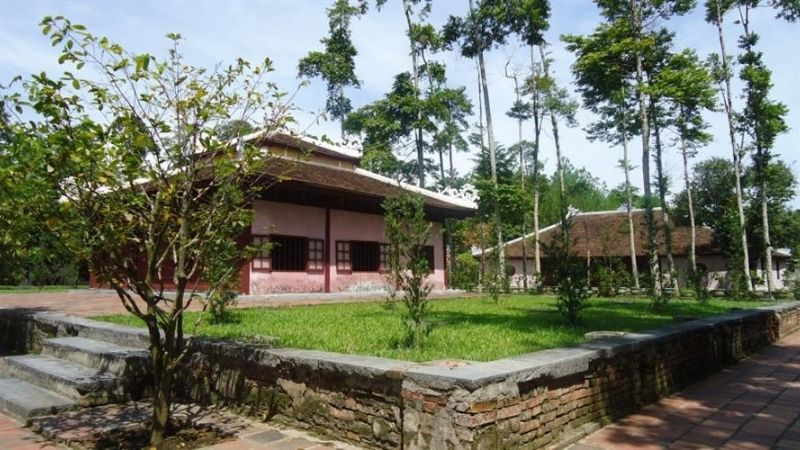
Tam Quan Gate of Thien Mu Pagoda
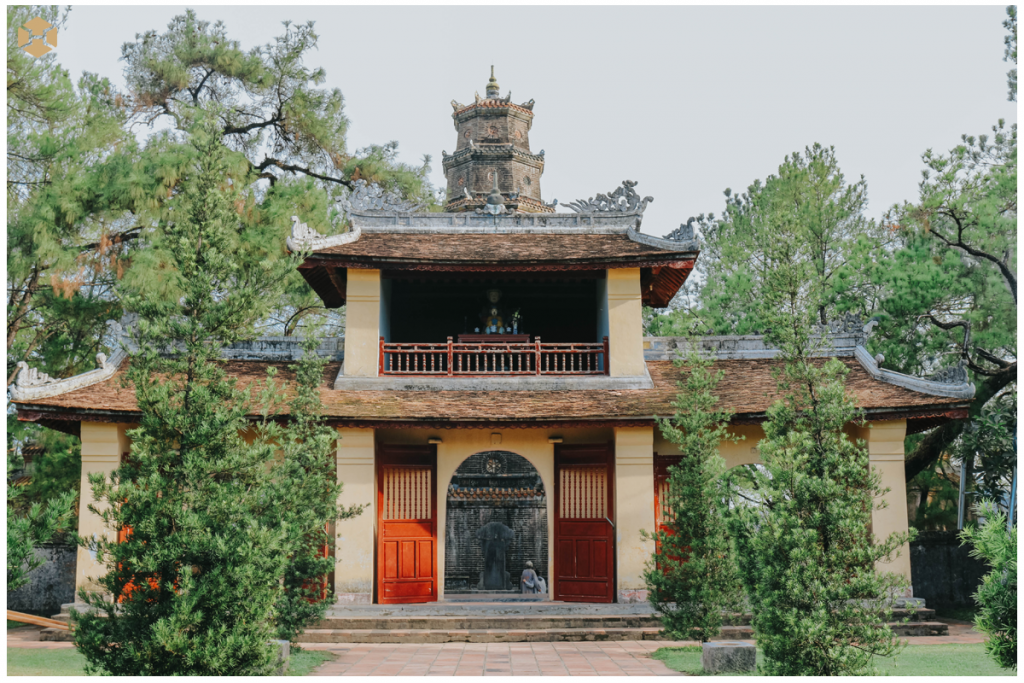
Tam Quan Gate is the main gate leading to the temple with a structure of 2 floors, 8 roofs and 3 aisles. At each entrance through the gate, there is a wooden plank door, on both sides there are guarding statues. Stepping through Tam Quan gate, you will admire 12 giant wooden temple guardian sculptures.
Attractive Tourist Spots Near Thien Mu Pagoda in Hue
If you have visited Thien Mu Pagoda in Hue, don’t forget to explore some of the hottest nearby attractions such as:
Perfume River (Huong River): The Perfume River, also known as the Huong River, is a picturesque waterway that flows right by Thien Mu Pagoda. Taking a boat ride on the Perfume River offers a serene and enchanting experience. The boat journey allows you to admire the scenic beauty of the surrounding landscapes, including lush greenery, ancient temples, and traditional villages along the riverbanks. The Perfume River is not only a source of natural beauty but also holds historical significance for the region.

Hue Imperial City: Just a short distance from Thien Mu Pagoda, the Hue Imperial City is a UNESCO World Heritage Site and a must-visit destination for history enthusiasts. It served as the political, cultural, and religious center of the Nguyen Dynasty, the last feudal dynasty in Vietnam. The Imperial City features well-preserved palaces, gates, courtyards, and temples, showcasing the rich architectural heritage of Vietnam. Exploring the Imperial City provides a glimpse into the country’s royal history and ancient architectural marvels.
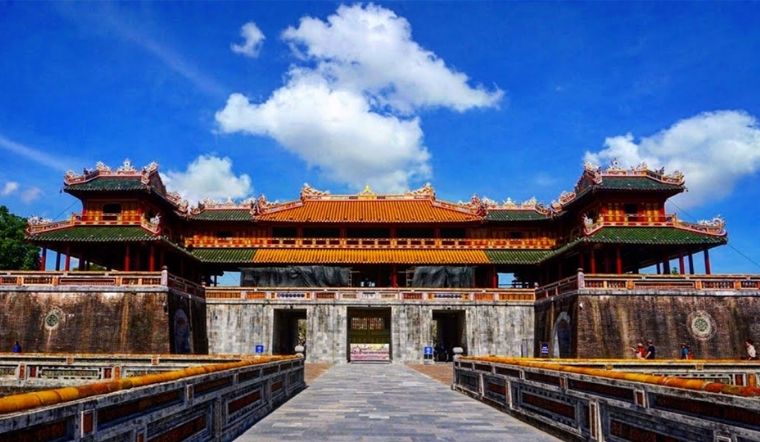
Dong Ba Market: Dong Ba Market is a vibrant and bustling marketplace located near Thien Mu Pagoda. It is one of the oldest and largest markets in Hue, offering a wide array of goods such as fresh produce, local handicrafts, textiles, and souvenirs. Visiting Dong Ba Market provides an authentic experience of Vietnamese daily life and allows travelers to indulge in the local flavors, aromas, and colors. It’s an excellent place to shop for souvenirs and immerse yourself in the local culture.

Vong Canh Hill: Vong Canh Hill is a scenic viewpoint overlooking the Perfume River and the surrounding countryside. The hill offers breathtaking panoramic views of the river, lush forests, and distant mountains. It is a popular spot for photographers, nature enthusiasts, and couples seeking a romantic setting. Watching the sunset from Vong Canh Hill is a magical experience, as the changing hues of the sky cast a serene ambiance over the landscape, creating a perfect backdrop for memorable moments.

Tips for Visiting Thien Mu Pagoda in Hue
Here are some tips and important points to know when traveling to Thien Mu Pagoda in Hue:
- Dress Modestly: Wear appropriate and modest clothing.
- Respectful Behavior: Avoid laughter, loud noises, pushing, and shoving. Be conscious of maintaining order to ensure the serenity and solemnity of the pagoda.
- Prepare Necessary Items: Bring essential items such as hats, sunglasses, and sun umbrellas to protect yourself from the sun. Stay hydrated and dispose of litter in designated areas.
- Souvenir Shopping: Inside the pagoda, there are stalls selling souvenirs such as conical hats, jewelry, and traditional Vietnamese dresses (ao dai). You can visit these stalls to buy gifts for your family and friends.
After exploring Thien Mu Pagoda, your taste buds will likely crave some culinary delights. There are plenty of excellent eateries near the pagoda offering Hue’s specialties such as banh beo and nam along Nguyen Thai Hoc Street, Hue Beef Noodle at Le Loi Street, che Hem at Hung Vuong Street, and banh canh cua (crab noodle soup). Enjoy the local delicacies to refuel your energy after your visit to Thien Mu Pagoda.
With its rich historical background, Thien Mu Pagoda rightfully earns the title of “The First Ancient Temple” in the heart of Hue’s ancient capital. Whenever people mention temples in Hue, they instinctively mention the name of this pagoda. Situated beautifully next to the poetic Perfume River, you can enjoy a boat ride on the Perfume River while admiring the tranquility of Thien Mu Pagoda.

